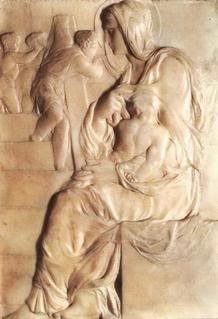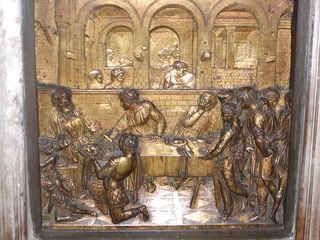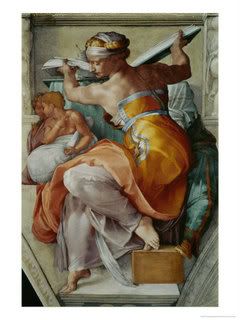Ladies and Gentlemen, meet Madonna of the Stairs:
This low-relief sculpture, completed around 1491, is the earliest surviving work of Michelangelo, done when he was still a teenager. What we have here is the Virgin Mary, sitting on the base of a staircase, nursing the Christ child. While in today's society breastfeeding in public isn't exactly the most accepted practice, in Medieval and Renaissance Italy, images of the Virgin nursing Christ, or Madonna Lactans were quite common. The idea behind it was that just as Mary gave physical nourishment to Jesus, so too does she give spiritual nourishment to the faithful. It is no coincidence that the perspective of the viewer lines up with the position of Christ in the scene, making the metaphor physically relevant too. It's really a nice idea, and for me I think that images of Madonna Lactans could even go a step further in reminding the viewer of Christ's humanity. It's so easy to think of the life of Jesus as the Nativity, then skip ahead 30 years and we have a full-grown man talking about God with all this authority. In actuality, Jesus was born and aged just like the rest of us, his mother supporting him the whole way, starting from the very beginning. The intimacy of a mother nursing a child is something that millions of people can relate to, yet don't necessarily think of in terms of the Holy Family.
I think this piece is especially cool because it is from very early in Michelangelo's career, so you can see his influences, but also the beginnings of the style that he later becomes so known for. He was influenced largely by Donatello, who died nine years before Michelangelo was born, but who was really notable for his shallow relief sculpture, like in The Feast of Herod (1425):
He is also really influenced by Greek sculpture, which we can see in Mary's profile, and also in the weight and style of her robes and how they fall around her body. But while it's easy to see where he's coming from, it's also easy to see where he's going, particularly in the modeling of the figure's bodies. Look and the Virgin's hands and feet, and the musculature in the Christ child, especially in his right arm. Michelangelo becomes very well known for how he shapes the human body, but I think that's a topic for another post. But for now, check out the Libyan Sibyl from the Sistine Ceiling and you might see what I mean.
Three more fun facts:
Madonna of the Stairs is seated on some stairs, but guess where they go to. That's right, HEAVEN. The concept of the Stairway to Heaven was around long before Jimmy Page and Robert Plant graced this planet.
While we're on the topic of breastfeeding, Michelangelo joked that he got his affinity for marble from his wet nurse, who was from a family of stone cutters in the town of Settignano, famous for their marble quarries. He supposedly told Giorgio Vasari "I sucked in with my nurse's milk the chisels and hammers with which I made my sculptures." A little creepy and gross, but funny.
In the background of the image there are some kids, and two of them are playing with a large piece of cloth. This might be an allusion to the burial shroud that will play a part in the baby's future.
This relief sculpture in marble can be seen in the Casa Buonarotti, in Florence.
Wednesday, February 4, 2009
Madonna of the Stairs
Labels:
Donatello,
Florence,
Italy,
madonna lactans,
Michelangelo,
Renaissance
Subscribe to:
Post Comments (Atom)




Hooray!! Which one of these is in Florence? Did i just miss that?
ReplyDeleteMiss you. I'm gonna follow you too.
Madonna of the Stairs is in Florence. I think Feast of Herod is in Sienna- not sure about that. And the Sistine Chapel is in Rome. go see them all. thanks for following me!
ReplyDeletewow, i love you and your nerdy blog!! consider yourself bookmark'd. i need to get my art history fun facts somehow...
ReplyDelete- elisa
Good Greif you ara a smart kid! You must come from good stock!
ReplyDeleteI love it! Madonna Lactans...Stairway to Heaven... lovely. awesome.
ReplyDelete